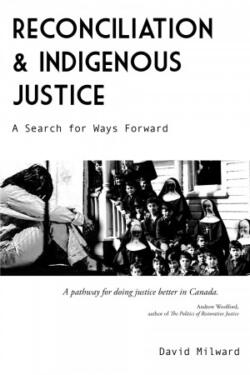1685 Vexation and reconciliation
Two books reviewed by Harper Campbell:
Standoff: Why Reconciliation Fails Indigenous People and How to Fix It
by Bruce McIvor
Gibsons: Nightwood Editions, 2021
$21.95 / 9780889714205
*
Reconciliation and Indigenous Justice: A Search for Ways Forward
by David Milward
Black Point, NS, and Winnipeg, MB: Fernwood Publishing, 2022
$32.00 / 9781773635194
*
 This is a review of two different books on the intersection of Canadian law and Indigenous people. The first is Standoff: Why Reconciliation Fails Indigenous People and How to Fix It (2021) by Bruce McIvor (Métis), which is mostly about Indigenous groups taking the government to court as a means of redressing harms. The second, Reconciliation and Indigenous Justice: A Search for Ways Forward (2022) by David Milward (Beardy’s & Okemasis Cree) is about criminal law and the overrepresentation of Indigenous people in the justice system.
This is a review of two different books on the intersection of Canadian law and Indigenous people. The first is Standoff: Why Reconciliation Fails Indigenous People and How to Fix It (2021) by Bruce McIvor (Métis), which is mostly about Indigenous groups taking the government to court as a means of redressing harms. The second, Reconciliation and Indigenous Justice: A Search for Ways Forward (2022) by David Milward (Beardy’s & Okemasis Cree) is about criminal law and the overrepresentation of Indigenous people in the justice system.
Most of McIvor’s Standoff is made up of previously published essays and columns. Many of them are accessible online, and if you want a taste of what’s in the book you can read a sample here. It’s been over ten years that McIvor has spent explaining the context and consequences of important rulings, and he has amassed a large back catalogue of pieces that he has arranged here mostly in a chronological order.
Because these pieces are mostly left as they were when first published (to respect their embeddedness in history, as McIvor puts it in the introduction), the result feels like a play-by-play retelling of the past decade or so of legal history as it pertains to Indigenous people. I think this aspect of the book could be a problem for some readers. It would have helped me, personally, to have a section that summarizes and connects all of these rulings. It’s like hearing about a chess match over the radio — it takes some mental effort to figure out where each move leaves the players.

At the same time, this play-by-play structure has many benefits. First of all, the pieces are short and sweet. It’s easy to pick up this book for a brief read and then put it down again. Also, it does lend itself to a feeling of history unfolding. We get to see these rulings not as isolated events, but as parts of a larger strategic narrative where each “team” tries to outflank the other.
A serious focus of this struggle is the duty to consult and accommodate. This duty was enshrined in the 1982 Constitution, and it requires that whenever the government is planning to make a decision that will affect Aboriginal or Treaty rights, it must consult with the affected people and if necessary accommodate them. As McIvor tells it, it first became an important tool for Indigenous peoples with the 2004 Haida Nation decision (p. 135). However, starting with the Rio Tinto decision of 2010, many court decisions took an extremely narrow view of the duty to consult and accommodate (p. 65). They permitted the government to handpick a small number of factors to consider before concluding that no Aboriginal or Treaty rights were infringed upon. Likewise, until the 2017 Clyde River decision, the courts allowed governments to bundle the duty to consult and accommodate into environmental assessments (p. 87). And even following these corrections, the Supreme Court, in telling the government what it must do in order to fulfill the duty to consult and accommodate, often gives it a way of proceeding to avoid consulting and accommodating (p. 135).
This short explanation of the duty to consult and accommodate leaves out many of the twists and turns in the story. But just the parts I’ve included above leave the reader with the unmistakable impression that the Canadian government (at all levels) sees its job as finding a way to circumvent the wishes of Indigenous groups. McIvor puts it bluntly:
Even when they [Indigenous people] overcome the odds and the imbalance of power and resources between themselves and government and industry and wrest a favourable decision from the Supreme Court, the victory too often has little practical effect. Governments throw up numerous flimsy excuses for delays in “implementing” a Supreme Court decision or simply ignore it altogether (pp. 91-92).
All of this brings us to the question of reconciliation. Although it doesn’t take up too many pages of this book, reconciliation is a key concept for McIvor. As he puts it in the piece entitled “Reconciliation as a Massive Failure,”
Reconciliation continues to fail because it attempts the impossible — the reconciliation of a right with a lie. The right is the pre-existing interest Indigenous Peoples had and continue to have in their land and the right to make decisions about their land before and after the colonizers’ arrival….
The lie is that through simply showing up and planting a flag, European nations could acquire an interest in Indigenous land and displace Indigenous laws.

Around the world, this racist legal principle is recognized as the Doctrine of Discovery. It was developed by the United States Supreme Court in the 1830s. In the Supreme Court of Canada’s 1990 Sparrow decision, where the court articulated for the first time the fundamental principles for interpreting section 35 of the constitution, it was welcomed as an essential principle of Canadian law.
The whole latter section of the book is devoted to pieces like this, which explore larger questions rather than stick to specific cases. McIvor trades his neutral, lawyerly language for a more impassioned, rhetorical stance, without losing the clarity and conciseness which marks his prose style throughout the book.
Three of these later pieces cover the Wet’suwet’en crisis that occurred in February of 2020. These events saw armed RCMP forces in Wet’suwet’en making sure that the Coastal GasLink pipeline would be put through the territory over the wishes of the inhabitants (although “the RCMP assured Canadians that the police officers tasked with dismantling Wet’suwet’en camps, handcuffing unarmed land protectors and marching them off to jail had first undergone cultural awareness training,” (p. 139). I followed these events quite closely, but I still found the three pieces in Standoff that treat this subject to be very illuminating about the issues involved.
Throughout McIvor’s Standoff, there is no doubt about the collective nature of the problems he discusses. By constitutional law, Aboriginal and Treaty rights are collectively held; and when those rights are infringed, it’s often groups of people (such as First Nations) that take the government to court.
*
 Turning to David Milward’s Reconciliation and Indigenous Justice, we encounter a much different situation. There are still many people who view criminal law as a matter of individual choices and individual punishments. There is a tendency, sometimes delivered with inflammatory rhetoric, to dissociate a person’s actions from their context, and to separate the punishments meted out from their overall result for communities. In the case of Indigenous people being prosecuted for breaking the law, the context is colonialism, and the mass incarceration that results only reinforces colonialism.
Turning to David Milward’s Reconciliation and Indigenous Justice, we encounter a much different situation. There are still many people who view criminal law as a matter of individual choices and individual punishments. There is a tendency, sometimes delivered with inflammatory rhetoric, to dissociate a person’s actions from their context, and to separate the punishments meted out from their overall result for communities. In the case of Indigenous people being prosecuted for breaking the law, the context is colonialism, and the mass incarceration that results only reinforces colonialism.
Thus Milward’s Reconciliation and Indigenous Justice is a book-length argument for the reader to take the context into account, to treat the criminal justice system as one cog in a larger system that works to oppress Indigenous people (to the harm of everyone). It can be roughly divided into two parts. In the first part, Milward addresses how colonialism, especially residential schools and the intergenerational trauma that has followed from them, affects the likelihood of someone breaking the law. In the second part, he argues that prisons only reinforce the underlying problems, and lays out a path to a post-carceral future.

To start with, a good reason to reject the explanation that dissociates actions from their context is the sheer number of Indigenous people who end up in prison. Indigenous people make up 27 percent of provincial/territorial inmates and 28 percent of federal inmates, even though Indigenous people only make up 3 percent of the overall population (p. 2). This is plainly a fact in need of explanation.
For Milward, that explanation includes military conquest, land dispossession, the taking of children by child welfare agencies, racial profiling, and other factors. But for Milward, the residential school system “has been and continues to be a critical cause behind Indigenous incarceration and it is arguably the most critical factor of all. It is likely that for almost every Indigenous person who ends up incarcerated, residential schools will form an important part of their background, even for those that did not themselves attend the schools” (pp. 2-3).
In the fourth chapter of Reconciliation and Indigenous Justice, Milward gives us a searing 25 pages of court rulings that attest to the connection between intergenerational trauma and crime. We hear again and again judges commenting that they believe these crimes would never have happened if it weren’t for residential schools and the impact of colonialism on Indigenous communities more generally. And yet the only choice available to a judge is how severely to punish the accused if found guilty.
In the second half of the book, Milward discusses how prisons only serve to reinforce the devastation in Indigenous communities, and thus the causes of crime. He quotes judge Heino Lilles on this point:
Jail has shown not to be effective for First Nation people. Every family in Kwanlin Dun [the Yukon] has members who have gone to jail. It carries no stigma and is therefore not a deterrent. Nor is it a “safe place” which encourages disclosure, openness, or healing. The power or authority structures within the jail operate against “openness.” An elder noted: “jail doesn’t help anyone. A lot of our people could have been healed a long time ago if it weren’t for jail. Jail hurts them more and then they come out really bitter. In jail, all they learn is ‘hurt and bitter’” (p. 81).
In order to address the underlying problems, justice must be restorative. It has to focus on reintegrating the individual successfully in the community. Milward thus proposes a shift to a restorative justice framework. He admits that restorative justice can go wrong, such as when it exacerbates power dynamics in communities, with disadvantaged victims feeling pressured to forgive someone more socially connected. He devotes a whole chapter (ch. 9) to the potential problems with restorative justice. He likewise admits that “prison cannot be completely dispensed with” (p. 177). Yet ultimately, if what is needed is to support communities wounded by colonialism, only a restorative vision of justice will work.
What is especially interesting about Reconciliation and Indigenous Justice is that Milward proposes Indigenous legal orders be the conduit through which restorative justice is implemented. Indigenous justice practices already have a lot in common with restorative justice:
One reason Indigenous justice is often likened to restorative justice is that many Indigenous societies in the past held councils to negotiate resolutions to conflicts. These councils typically involved the presentation of material gifts to the victim, or to the victim’s kin, as reparation for the offence. These gifts were often accompanied by apologies or acknowledgements of responsibility. The acceptance of the gifts signified the resolution of the conflict and the restoration of community harmony. This practice is known to have occurred among the Cree, the Anishinaabe, the Haudenosaunee, the Dene, the Twanas, Clallams, the Puyallups, the Nisquallys, the Mi’kmaq in New Brunswick, and the Coast Salish in British Columbia.

Furthermore, although Indigenous legal orders have been systematically undermined and treated as irrelevant by the federal and provincial governments, they are still as foundational to Canadian law as common law and civil law are (p. 70). (This is something McIvor points out in Standoff as well.) The revitalization of these orders is already necessary for reconciliation — for instance in Call to Action 42 of the TRC report — so Milward suggests that they form a natural fit.
Milward doesn’t get a chance to lay out a complete plan for the transition to fully revitalized Indigenous legal orders, a shift that won’t take place overnight in any case. Many of the suggestions in Reconciliation and Indigenous Justice are about the immediate steps that can be taken to reduce the harm that the criminal justice system does to Indigenous communities. But the University of Victoria, where Milward is a professor of law, has a joint program on common law and Indigenous legal orders, and we hope to see further explorations of this idea from them and from others working in this field (such as Val Napoleon, Hadley Friedland, and Tracy Lindberg). For anyone interested in a practical example of Indigenous legal orders in action, Milward gives an in-depth treatment of how that might look in the case of Christopher Pauchay (pp. 162-165).
There is a great deal more in Reconciliation and Indigenous Justice that hasn’t found its way into my review, from discussions of preventative programming (ch. 7) to the question of the politics of recognition (pp. 64-66 and elsewhere). Readers of the book will find that there are many dimensions to Milward’s argument that I haven’t done justice to.
Together, these two books help to paint a detailed picture of what is wrong with reconciliation as it is currently espoused by the government. The status quo is not reconciliation, as Milward puts it and as McIvor might just as easily have said. And the status quo is a situation where the government grants itself permission to ignore its own laws, and yet acts as if rethinking the criminal justice system would be a dangerous breach of fairness. This is the situation that E. Pauline Johnson/ Tekahionwake saw so clearly over a hundred years ago when she wrote “The Cattle Thief,” a poem that includes these lines:
You say your cattle are not ours, your meat is not our meat;
When you pay for the land you live in, we’ll pay for the meat we eat.
Give back our land and our country, give back our herds of game;
Give back the furs and the forests that were ours before you came;
Give back the peace and the plenty. Then come with your new belief,
And blame, if you dare, the hunger that drove him to be a thief.
This predicament has not changed in its essentials to this day, and will not change until Canadians and the Canadian government take reconciliation seriously as a call to change the way things fundamentally operate.
*

Harper Campbell has published poetry in Salish Seas: An Anthology of Text + Image (Aboriginal Writers Collective West Coast, 2011), an essay in The Salt Chuck City Review (volume 1, 2019), and translations of the Indonesian poet Chairil Anwar in Columbia Journal (2021) and Ezra (forthcoming). He has an honours degree in philosophy and Asian studies from the University of British Columbia. Editor’s note: Harper Campbell has also reviewed books by Aubrey Jean Hanson, Michelle Good, Joseph Dandurand, Margaret Laurence, jaye simpson, and Joshua Whitehead for The British Columbia Review.
*
The British Columbia Review
Publisher and Editor: Richard Mackie
Formerly The Ormsby Review, The British Columbia Review is an on-line book review and journal service for BC writers and readers. The Advisory Board consists of Jean Barman, Wade Davis, Robin Fisher, Barry Gough, Hugh Johnston, Kathy Mezei, Patricia Roy, Maria Tippett, and Graeme Wynn. Provincial Government Patron (since September 2018): Creative BC. Honorary Patron: Yosef Wosk. Scholarly Patron: SFU Graduate Liberal Studies.
“Only connect.” – E.M. Forster